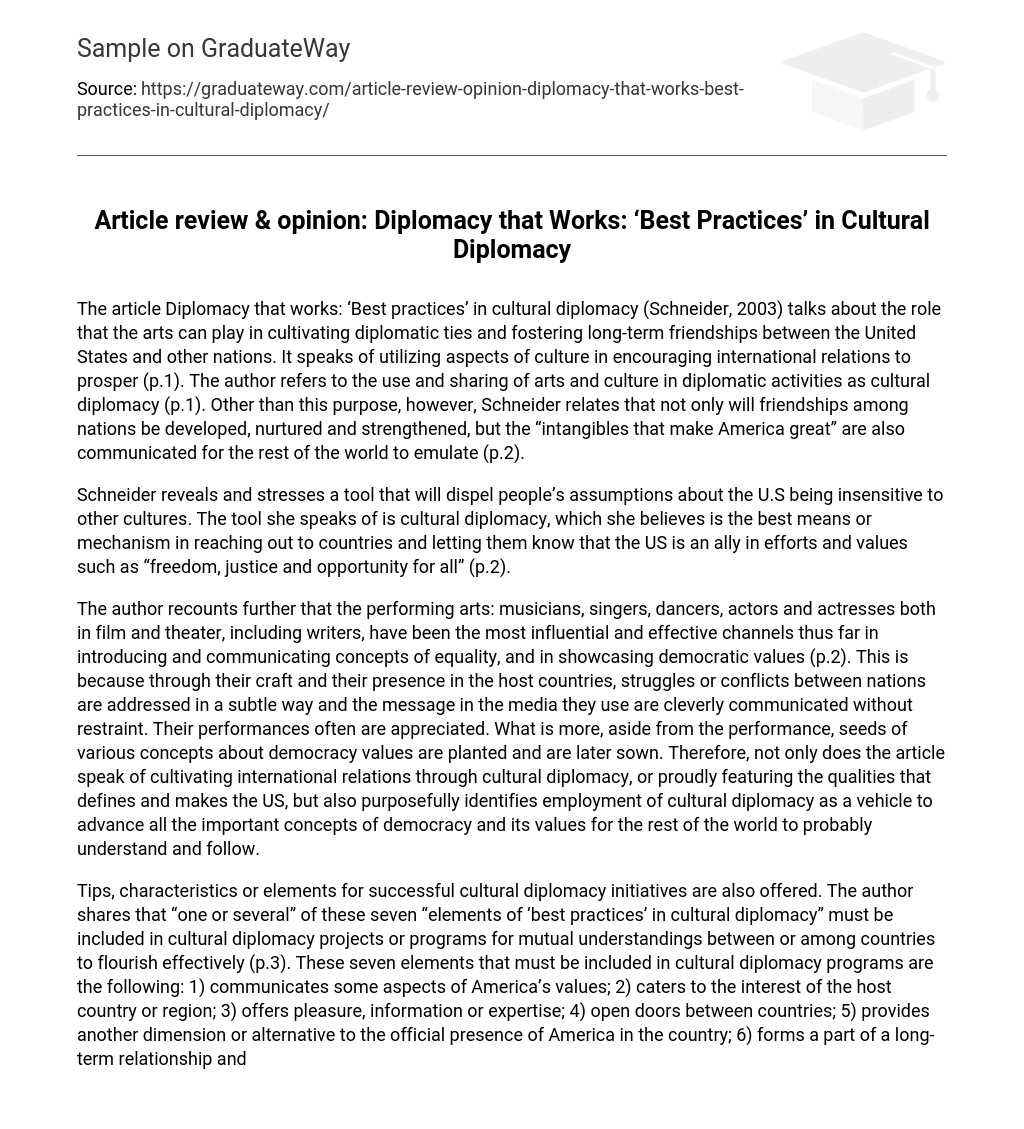The article Diplomacy that works: ‘Best practices’ in cultural diplomacy (Schneider, 2003) talks about the role that the arts can play in cultivating diplomatic ties and fostering long-term friendships between the United States and other nations. It speaks of utilizing aspects of culture in encouraging international relations to prosper (p.1). The author refers to the use and sharing of arts and culture in diplomatic activities as cultural diplomacy (p.1). Other than this purpose, however, Schneider relates that not only will friendships among nations be developed, nurtured and strengthened, but the “intangibles that make America great” are also communicated for the rest of the world to emulate (p.2).
Schneider reveals and stresses a tool that will dispel people’s assumptions about the U.S being insensitive to other cultures. The tool she speaks of is cultural diplomacy, which she believes is the best means or mechanism in reaching out to countries and letting them know that the US is an ally in efforts and values such as “freedom, justice and opportunity for all” (p.2).
The author recounts further that the performing arts: musicians, singers, dancers, actors and actresses both in film and theater, including writers, have been the most influential and effective channels thus far in introducing and communicating concepts of equality, and in showcasing democratic values (p.2). This is because through their craft and their presence in the host countries, struggles or conflicts between nations are addressed in a subtle way and the message in the media they use are cleverly communicated without restraint. Their performances often are appreciated. What is more, aside from the performance, seeds of various concepts about democracy values are planted and are later sown. Therefore, not only does the article speak of cultivating international relations through cultural diplomacy, or proudly featuring the qualities that defines and makes the US, but also purposefully identifies employment of cultural diplomacy as a vehicle to advance all the important concepts of democracy and its values for the rest of the world to probably understand and follow.
Tips, characteristics or elements for successful cultural diplomacy initiatives are also offered. The author shares that “one or several” of these seven “elements of ‘best practices’ in cultural diplomacy” must be included in cultural diplomacy projects or programs for mutual understandings between or among countries to flourish effectively (p.3). These seven elements that must be included in cultural diplomacy programs are the following: 1) communicates some aspects of America’s values; 2) caters to the interest of the host country or region; 3) offers pleasure, information or expertise; 4) open doors between countries; 5) provides another dimension or alternative to the official presence of America in the country; 6) forms a part of a long-term relationship and cultivation of ties; and 7) is creative, flexible, and opportunistic (p.3).
It is noted that two of the most important elements that must be included in such programs is that it should reflect or illuminate some aspects of US best values, and that it is suited for its audience (p.4). These elements have been provided to serve as guide for persons planning a program or programs that would adopt and utilize methods of cultural diplomacy.
Schneider considers the fact that a program must first “be suited to its audience” for it to become appreciated by the host country and therefore be successful in relaying messages that the US advocates (p.4). She notes that not everything that works in one host country will work for another. Therefore, it is imperative that the environment must first be understood for a cultural diplomacy program to work. The article moves on to discuss the rest of the seven elements identified as “elements of ‘best practices’ in cultural diplomacy”. Overall, the article is good in its attempt to promote the arts and the performing artists as effective vehicles and ambassadors of the US to the rest of the world. More information or a call to the artists could have been added to have them make their future work more meaningful and valuable.
Reference
Schneider, Cynthia P. (2003). Diplomacy that Works: ‘Best Practices’ in Cultural Diplomacy. Cultural Diplomacy Research Series. Center for Arts and Culture. www.culturalpolicy.org





